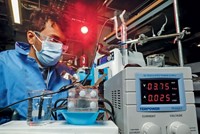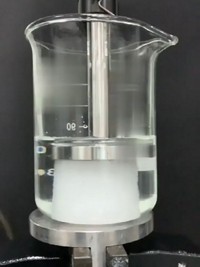Advertisement
Grab your lab coat. Let's get started
Welcome!
Welcome!
Create an account below to get 6 C&EN articles per month, receive newsletters and more - all free.
It seems this is your first time logging in online. Please enter the following information to continue.
As an ACS member you automatically get access to this site. All we need is few more details to create your reading experience.
Not you? Sign in with a different account.
Not you? Sign in with a different account.
ERROR 1
ERROR 1
ERROR 2
ERROR 2
ERROR 2
ERROR 2
ERROR 2
Password and Confirm password must match.
If you have an ACS member number, please enter it here so we can link this account to your membership. (optional)
ERROR 2
ACS values your privacy. By submitting your information, you are gaining access to C&EN and subscribing to our weekly newsletter. We use the information you provide to make your reading experience better, and we will never sell your data to third party members.
Environment
Nanotube-Based Filter Cleans Drinking Water
Water Treatment: New filtration system removes bacteria and viruses
by Emily J. Gertz
March 17, 2011

For 1 billion people in developing countries, finding clean drinking water is a daily challenge. Now researchers demonstrate a carbon nanotube-based filtration and electrolysis system that can completely remove or inactivate viruses and bacteria from water (Environ. Sci. Technol., DOI: 10.1021/es2000062). Coauthor Chad Vecitis of Harvard University thinks this technology could lead to inexpensive commercial water filters, potentially saving millions every year from diseases and death caused by waterborne pathogens.
The key filter in the device is a porous film of multi-walled carbon nanotubes. Compared to other carbon-based filtration techniques, nanotubes have several advantages, Vecitis says, including large surface areas, inherent antimicrobial activity, and resistance to corrosion. By running a small current through the nanotubes and inserting another electrode into the water, the device also can electrolyze water to produce oxygen to kill pathogens.
Vecitis and his colleagues tested their device by pumping suspensions of the bacteria Escherichia coli or of MS2 bacteriophages in a saline solution through the filter assembly. They ran these tests with and without electrolysis.
After one pass through the filter, their device successfully removed all bacteria from the solution, and 99.99% of the viruses. With electrolysis, no viable bacteriophages remained. Since a single virus particle can sicken a person, the researchers consider electrolysis an important step.
Because the electrolysis reaction requires low voltages, portable solar panels could power the device, Vecitis says. To adapt the technology to daily use, he says, the next step would be to create a more-compact device with the capacity to filter 2 to 3 L of water per day, the minimum people need to survive.





Join the conversation
Contact the reporter
Submit a Letter to the Editor for publication
Engage with us on Twitter